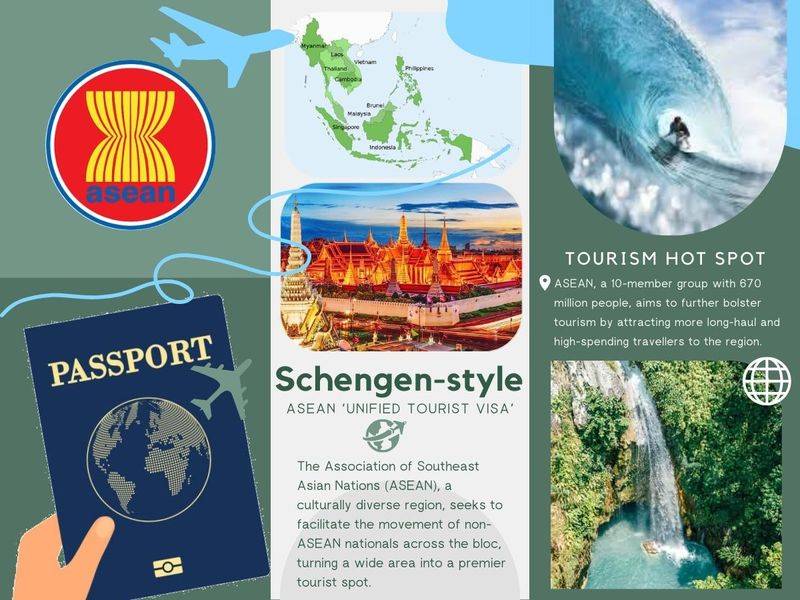Single Visa similar to Schengen under considertion for ASEAN members
The success of the initiative depends on resolution of bureaucratic hurdles

ASEAN countries are considering implementing a visa allowing non-ASEAN nationals to travel freely. This initiative aims to boost tourism and create the world's second-largest free movement area.
While the ASEAN visa may not rival Europe's Schengen visa, it could represent one of the most culturally diverse regions globally, making it an attractive destination for travellers worldwide. This concept has been under consideration for decades, and the ASEAN countries are now actively working on the logistics to make it a reality.
The ASEAN group, which has existed for 63 years, aims to cooperate in multiple economic, technical, and human resource development areas. However, this is difficult due to the challenges of having different foreign policies and rules.

When was the idea conceived?
The idea gained momentum during the 2016 ASEAN Tourism Forum in the Philippines, where ASEAN member-states officially launched the ASEAN Tourism Strategic Plan (ATSP) 2016-2025. Thailand's Prime Minister Srettha Thavisin has recently reignited the initiative, and the proposal has received broad regional support.
What countries are going to be included?
The current proposal would initially cover six geographically contiguous mainland Asian countries: Cambodia, Laos, Malaysia, Myanmar, Thailand, and Vietnam (CLMMTV). Last year, these six countries welcomed 70 million tourists, with Thailand and Malaysia leading the way, generating approximately $48 billion in tourism dollars.
Thailand's tourism industry is a vital part of its economy, providing employment to 20% of its workforce and contributing 12% to its $500 billion economy. To achieve its goal of welcoming 80 million tourists by 2027, Thailand has made it easier for visitors from different countries to enter and has diversified its tourism offerings with various events.
Which countries in ASEAN are not part of the proposed joint visa programme?
The proposal excludes non-mainland member economies: Brunei, Indonesia, The Philippines, and Singapore.
How likely is it that a unified ASEAN visa will happen?
This idea is still being discussed, and timelines for its implementation have yet to be set. One significant challenge that needs to be addressed is harmonising different immigration apparatuses and databases, which has been considered the most crucial hurdle until now.
Harmonising immigration policies is far more challenging than harmonising business or tax regimes. This goal is only possible by creating a system similar to the European Union (EU), where member countries are like one country in all but name. It currently requires more work to imagine how ASEAN could achieve such a level of integration.

Challenges to Overcome for Successful Implementation of the ASEAN Joint-Visa Programme
Implementing a standardised tourist program among ASEAN participating nations requires addressing several challenges. One of the main challenges is coordinating approvals and establishing standard criteria for tourists. Another challenge is the fragmented nature of ASEAN and its immigration database, which creates further hurdles.
Moreover, several factors hinder the scheme's implementation, including security concerns, issues with internal sharing mechanisms, border control support, visa issuance synchronisation, and the need for human resource development and infrastructure upgrades.
The success of the ASEAN joint visa programme relies on the speed at which participating states can overcome bureaucratic hurdles and gain sufficient support from all nations involved.
The Philippines is a significant contributor to the success of this initiative.
There are several reasons why the Philippines should sign up for the Unified ASEAN Visa scheme. First, as a founding group member, the Philippines is a key driver of this initiative. Second, it will enhance institutional cooperation within the region. Third, tourism from neighbouring countries would significantly boost the economy, thus benefiting all members involved.
Scheme's objectives
The scheme aims to improve ASEAN security governance by promoting better inter-agency and regional collaboration. This will enhance border management capabilities, leading to more robust ASEAN security governance. Despite the challenges, a 2018 study reveals that the Philippines' Bureau of Immigration (BI), Department of Foreign Affairs (DFA), and embassy officials are optimistic about the scheme's overall benefits for the Philippines and the ASEAN region.
Why is it more feasible to have a unified ASEAN visa that is scaled down?
A potential "unified ASEAN tourist visa" plan that is initially limited to 90 days and only for mainland Asian countries is more likely to be adopted, according to Ben Hart, the Managing Director of Integrity Legal based in Bangkok. This is due to the existing initiatives where all member economies promote tourism. Thailand, for example, has been pursuing tourism drives such as reciprocal visa waiver deals and temporary visa waivers for travellers from critical markets like China and India. Thailand has ambitious goals to become a tourism hotspot and an aviation and logistics hub.

What happens next?
If countries in the region decide to have a standard visa, it would signify increased collaboration within the area and help establish greater integration towards a shared ecosystem for their citizens and the world.
Allowing tourists to travel to any country in the region with one travel document would likely stimulate tourism and add more economic value. Although it may only happen sometime soon, we may see a pan-ASEAN visa becoming a reality at some point in the future.
Story credit: Gulf News

